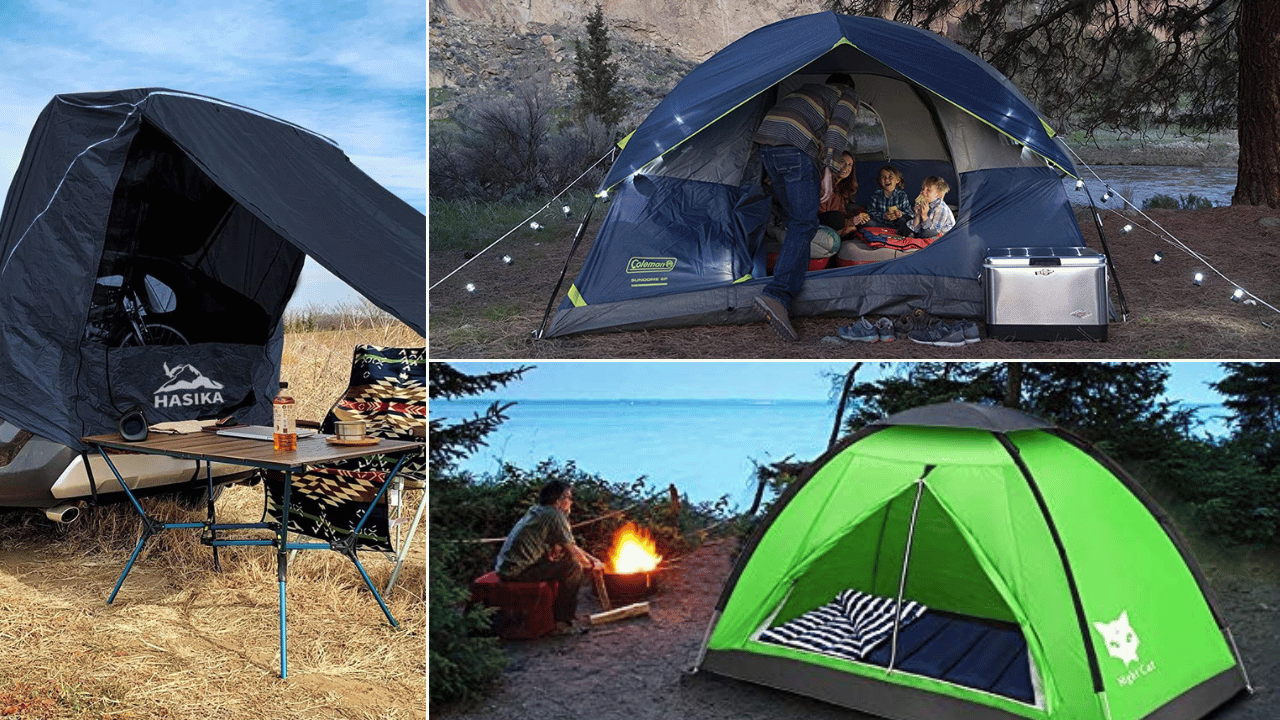Stay Dry and Adventure On How to Waterproof a Tent
If you've ever gone camping, then you know that one of the most important things is to make sure your tent is properly waterproofed.
Picture this: You're nestled in a beautiful forest, the sun setting, and the sounds of nature all around you. Then, the unexpected happens—it starts to rain. To ensure that your camping adventure doesn't turn into a soggy nightmare, it’s crucial to have a waterproof tent. In this guide, we'll explore why waterproofing a tent is essential for outdoor enthusiasts, hikers, and campers alike. By the end, you'll know exactly how to keep your tent dry, maintain its protection, and extend its life.
Understanding the Waterproofing Needs of Different Tent Types
Dome Tents and Their Waterproofing Needs
Dome tents are popular choices for many campers due to their ease of setup and stability in moderate wind conditions. However, their curved design means that rain can easily run off the sides. Dome tents typically come with a rainfly—a separate waterproof cover that shields the tent. To enhance waterproofing, it’s essential to seal the seams with a seam sealer or Seam Grip and apply a waterproof spray to the rainfly.
Family Tents and Tent Floor Waterproofing Considerations
Family tents, being larger, often have more seams, making them susceptible to leaks. These tents are designed for comfort and space, but their size can be a challenge when it comes to waterproofing, making it essential to consider the tent waterproof rating. It’s important to check the tent’s flooring for any weak spots and reinforce them with a waterproofing treatment. In addition to the flooring, it’s also important to check the tent body for any weak spots and reinforce them as needed. Additionally, a ground tarp underneath can prevent moisture from seeping in.
Backpacking Tents and Lightweight Waterproofing
Backpacking tents are designed to be lightweight and compact, making them ideal for hikers covering long distances. Given their minimalist design, they may not always come with robust waterproofing features. It’s advisable to treat the tent's fabric with a waterproof spray and ensure that the zippers are sealed properly to prevent water ingress.

Recognizing When Your Tent Needs Waterproofing
Visible Signs of Wear and Tear
Frequent use can lead to visible wear and tear on your tent. Over time, the waterproof coating may start to peel or crack, especially around high-stress areas like all the seams and corners. If you notice any of these signs, it’s time to reapply a waterproofing treatment.
Persistent Dampness Inside the Tent
If you find your tent's interior feels consistently damp, even when it hasn’t rained, it might be a sign that the waterproofing has worn off. This issue can occur due to condensation buildup that the tent fabric can no longer repel. A fresh coat of waterproof spray can restore its ability to keep moisture at bay.
Leaks and Drips from the Rain Fly
One of the clearest indicators that your tent needs waterproofing is if it starts leaking during rain. This can happen if the seams are no longer sealed tightly or if the waterproof coating has deteriorated, making it necessary to seal seams again. Addressing these leaks promptly can prevent further damage and keep your camping trip dry and comfortable.
Step-by-Step Guide to Waterproofing Your Tent
Preparing Your Tent for Waterproofing
Before applying any waterproofing products, ensure your tent is clean and dry. Check the tent for any signs of wear, particularly on the urethane coating, which may need refreshing. Set it up in a well-ventilated area and gently scrub any dirt or debris using a soft brush and mild soap. Rinse thoroughly and allow it to air dry completely.
Tent Floor Waterproofing
Waterproofing the tent floor is a crucial step in ensuring a dry and comfortable camping experience. The tent floor is more prone to water damage than the walls or rain fly, as it is in direct contact with the ground. To waterproof the tent floor, you can use a seam sealer or a waterproofing spray specifically designed for tent floors.
When choosing a waterproofing product for your tent floor, make sure to select one that is compatible with the material of your tent. Some products may not be suitable for certain types of fabric, so it’s essential to read the instructions and follow the manufacturer’s recommendations.
In addition to using a waterproofing product, you can also take steps to prevent water from seeping into the tent floor. One way to do this is to use a ground tarp, which can be placed under the tent to create a barrier between the tent floor and the ground. You can also use a tarp on the floor inside the tent to add an extra layer of protection.
Applying Seam Sealer for Maximum Protection
Seams are the most vulnerable part of your tent when it comes to water penetration, so it’s crucial to apply a seam seal for maximum protection. Apply a seam sealer to both the inside and outside of the seams for maximum protection. Use a brush or applicator to work the sealer into the seams and ensure full coverage. Allow it to dry completely before moving on to the next step.
Using DWR Coating for Fabric Reinforcement
Once your seams are sealed, apply a DWR spray to the entire tent, focusing on the rainfly and outer fabric. Hold the spray can about 6 inches away and apply an even coat. Pay special attention to areas that receive the most wear. Allow the tent to dry thoroughly before packing it away.
Choosing the Right Materials
When it comes to waterproofing your tent, choosing the right materials is essential. You’ll need to select a waterproofing product that is compatible with the material of your tent, as well as a seam sealer that can effectively seal the seams.
For tent floors, a waterproofing spray or seam sealer specifically designed for tent floors is recommended. These products are usually made with a durable water repellent (DWR) coating that can withstand the elements and keep your tent floor dry.
For the rain fly and tent walls, a waterproofing spray or DWR coating can be used to repel water and prevent leaks. These products can be applied to the fabric of the tent to create a water-resistant barrier.
Material Compatibility and Effectiveness
When choosing a waterproofing product, it’s essential to consider the material compatibility and effectiveness of the product. Different materials require different types of waterproofing products, and using the wrong product can damage your tent or reduce its effectiveness.
For example, if you have a tent made of nylon or polyester, you’ll need a waterproofing product that is compatible with these materials. A product that is designed for use on cotton or canvas may not be effective on nylon or polyester.
In addition to material compatibility, you’ll also need to consider the effectiveness of the product. Look for products that have been tested and proven to be effective in waterproofing tents.
Maintaining Your Tent's Waterproofing
Regular Cleaning and Inspection
Regularly clean your tent to prevent dirt and grime from weakening the waterproof coating. Inspect the seams and fabric for signs of wear every few uses. By catching potential issues early, you can address them before they become significant problems.
Proper Storage Techniques
Proper storage is crucial for maintaining your tent's waterproofing. Ensure your tent is completely dry before packing it away to prevent mold and mildew. Store it in a cool, dry place, and avoid compressing it too tightly to preserve the fabric’s integrity.
Periodic Reapplication of Waterproofing Products
Even with the best care, the water repellent coating and other waterproofing treatments can wear off over time. To ensure your tent remains watertight, reapply waterproofing products at least once a season, or more frequently if you camp often. Regular maintenance will extend your tent’s lifespan and keep it performing at its best. In addition to your tent, it's also important to periodically check and maintain other camping gear, such as your sleeping bag, to ensure it remains in good condition and provides the necessary protection during your outdoor adventures.
Common Mistakes to Avoid
When waterproofing your tent, there are several common mistakes to avoid. One of the most common mistakes is overlooking key areas of the tent, such as the seams and stitching. These areas are prone to leaks and can compromise the waterproofing of the tent.
Another common mistake is using the wrong type of waterproofing product. Using a product that is not compatible with the material of your tent can damage the fabric or reduce the effectiveness of the waterproofing.
Finally, failing to follow the manufacturer’s instructions can also compromise the waterproofing of the tent. Make sure to read the instructions carefully and follow the recommended application procedures.
Additional Tips and Tricks
The Advantages of a Fully Waterproof Tent
Enhanced Comfort and Safety
A waterproof tent provides enhanced comfort by keeping you dry and protected from the elements. It also offers safety by preventing water-related hazards, such as hypothermia, during unexpected weather changes.
Longevity and Durability
Investing in waterproofing extends the life of your tent. By protecting the fabric and seams, you prevent premature wear and tear, ensuring your tent can withstand multiple camping trips.
Stress-Free Camping Experiences
With a properly waterproofed tent, you can enjoy your camping adventures without worrying about unexpected rain showers. You’ll have peace of mind knowing that you and your gear will stay dry, allowing you to focus on making memories in the great outdoors.
Recap and Encouragement to Share
In conclusion, waterproofing your tent is a vital step in ensuring a successful and enjoyable camping experience. By understanding your tent’s needs, recognizing signs of wear, and following proper waterproofing techniques, you can keep your tent in top condition for years to come. We encourage you to share your own waterproofing tips and experiences with fellow outdoor enthusiasts.
Happy camping!


